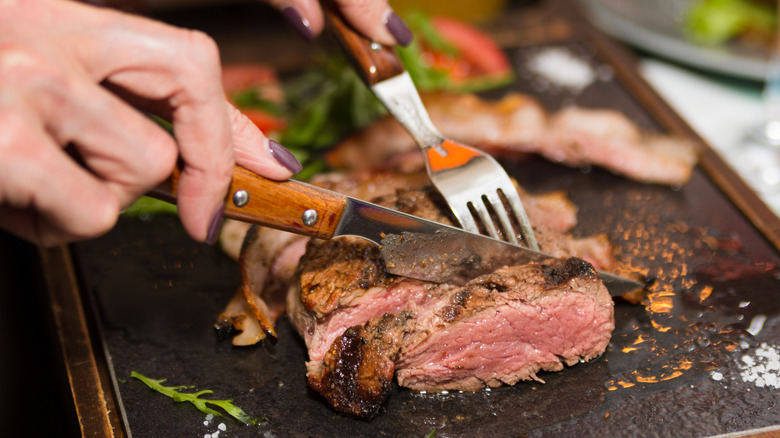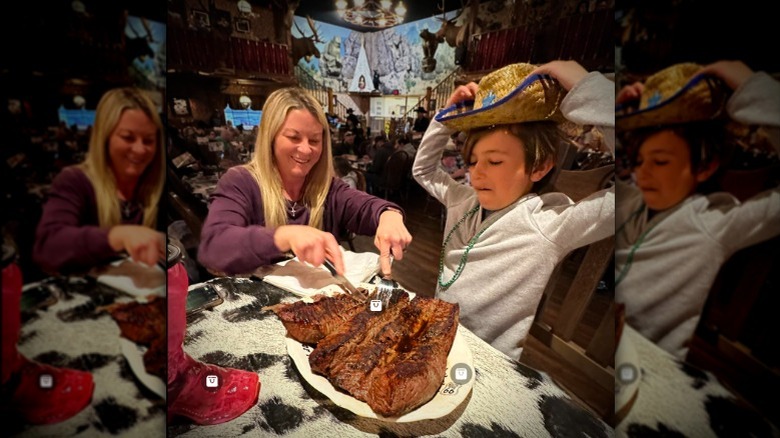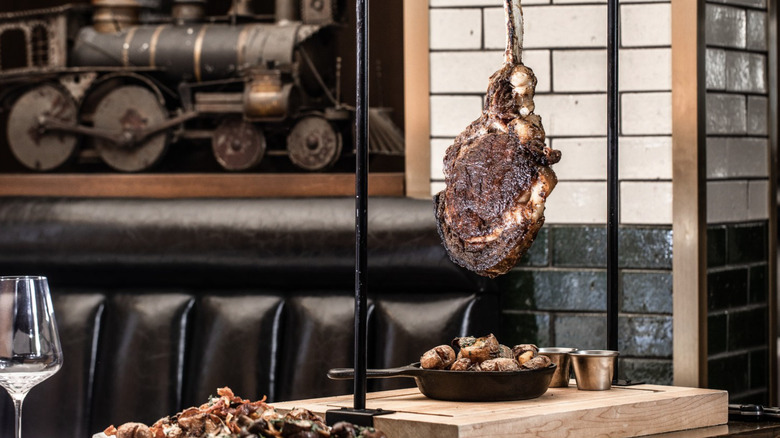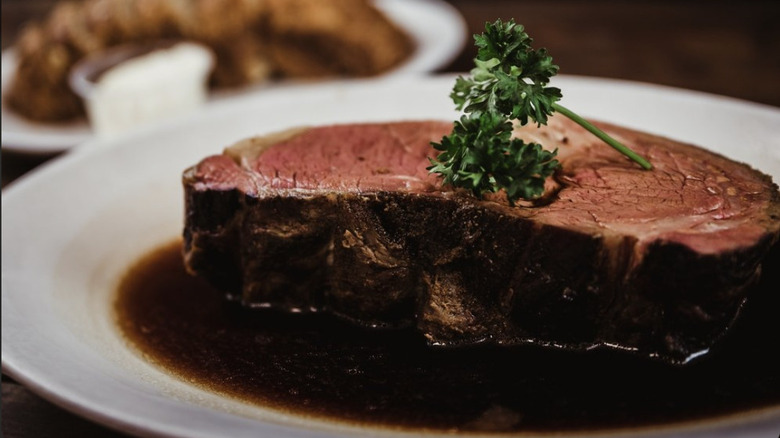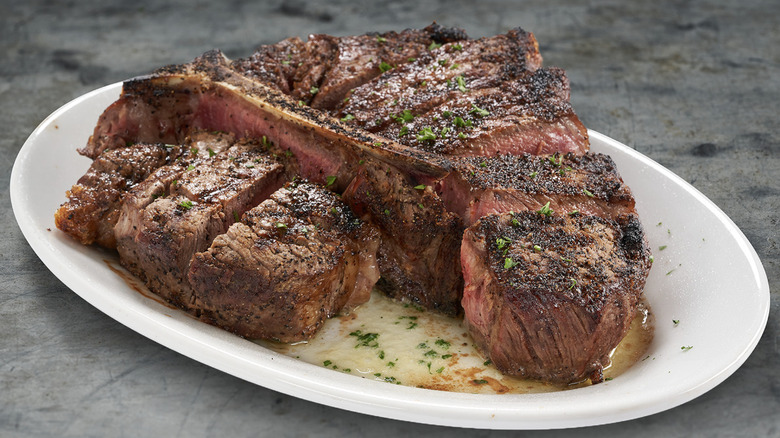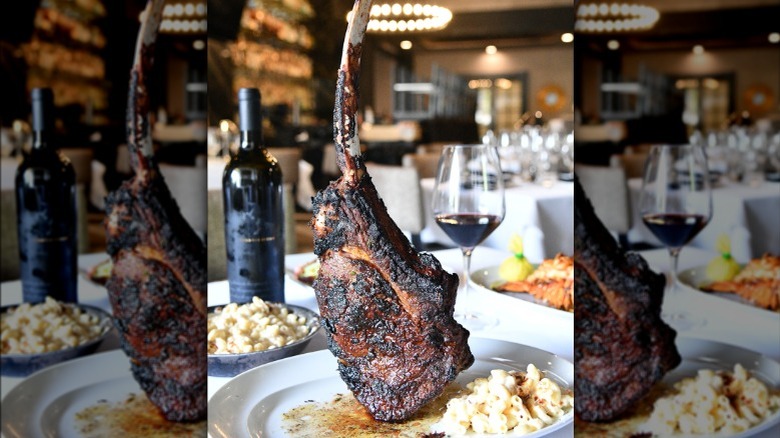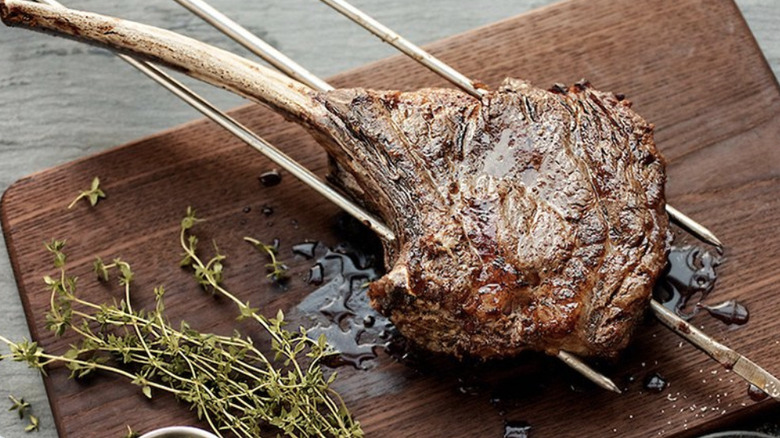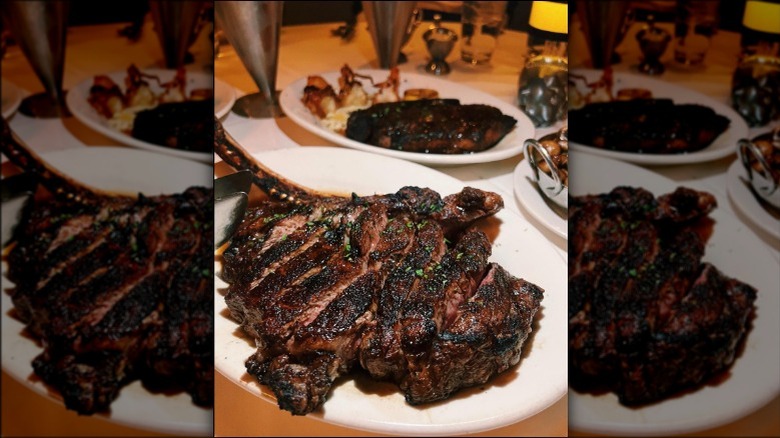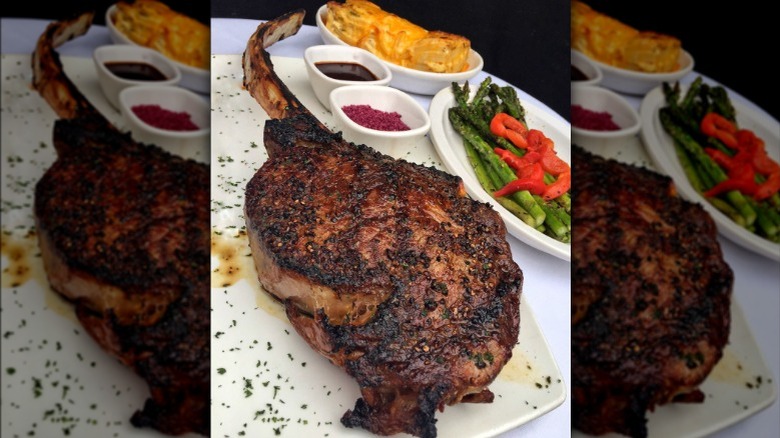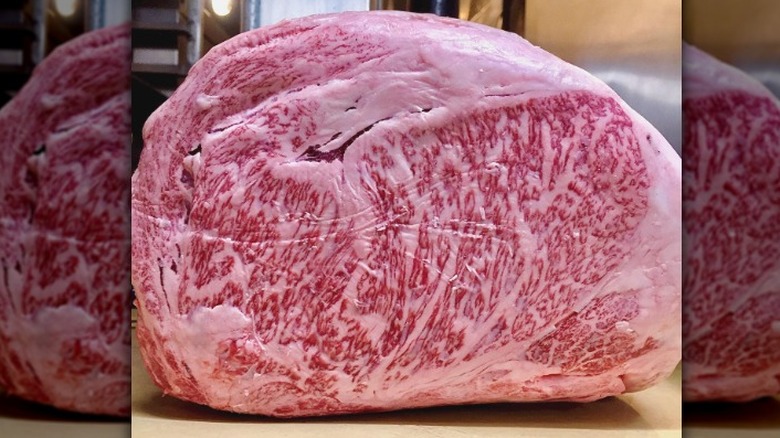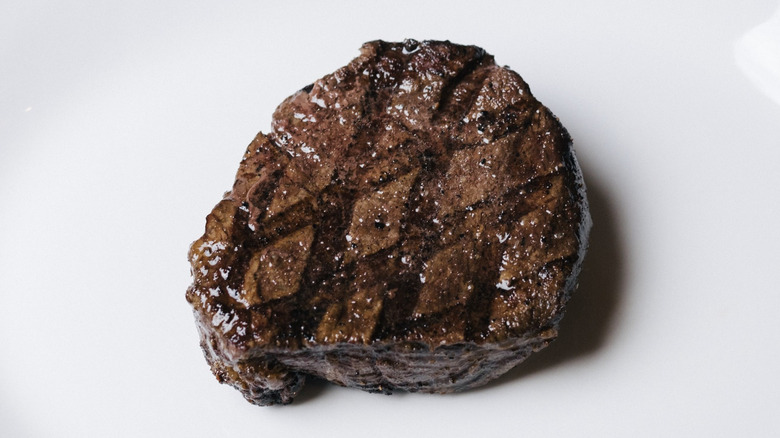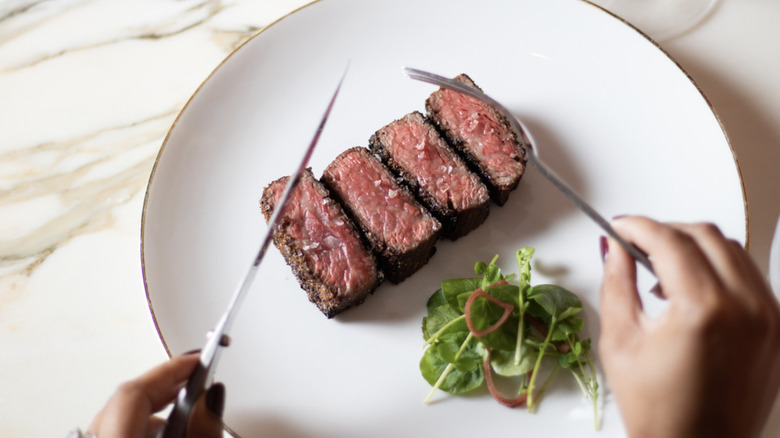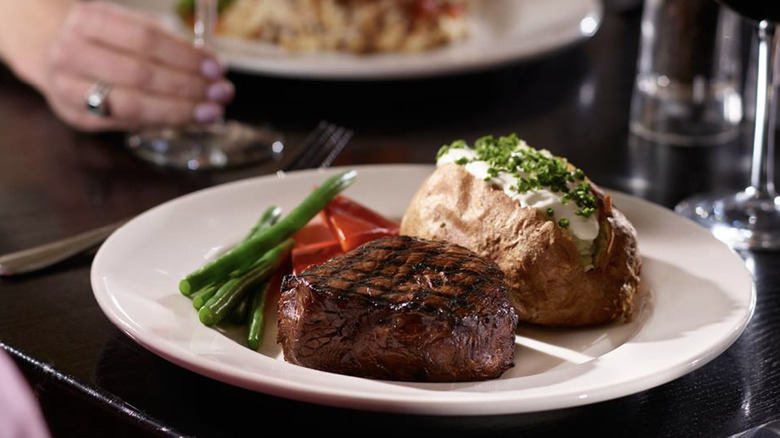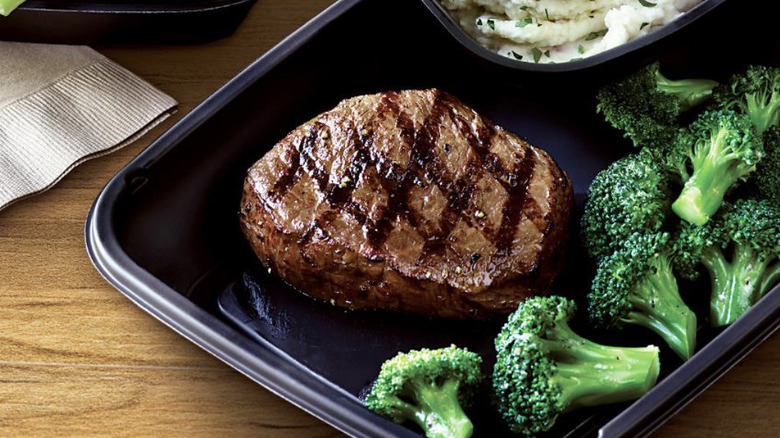Steakhouses That Serve The Biggest & Smallest Steaks
Whether it's celebrating a special occasion with family or friends at a fancy restaurant or having a casual meal while out on the town, steaks are a common go-to menu choice for carnivores. And there's a good reason why. Flavorful, juicy, and tender, a well-seared steak is a treat for the senses. From perfectly cooked filet mignons to juicy ribeyes, steaks are also ultra versatile, which means that there is a cut out there for every palate and preference.
According to Delighted Cooking, the average steak served at a U.S. restaurant weighs 14 ounces (this is over four times the recommended serving size, but that's another story). This, however, isn't a given since many steakhouses serve a range of steak sizes to cater to different appetites and preferences. Some restaurants offer portions as small as 3 ounces, whereas others may offer cuts as large as 40 ounces.
Since not all steaks are created equal, it pays to know what you're getting yourself into. After all, there's little point asking for a petite filet mignon to satisfy a mammoth appetite. On the flip side, there's little sense in ordering a tomahawk steak if you aren't particularly hungry. Curious to know more? Take a look at our list of steakhouses that serve the biggest and smallest steaks.
The Big Texan Steak Ranch
At 72 ounces, the steak served at The Big Texan Steak Ranch may just be the largest in the country. And you don't even have to spend a cent to down the mouth-watering masterpiece since it's a part of the restaurant's steak dinner challenge. All you have to do to take the challenge is turn up — no reservations are required.
Becoming a 72-ounce steak champion is a whole other story. Over the years, over 91,000 steak enthusiasts have attempted to devour the gargantuan cut (plus the obligatory shrimp cocktail, baked potato, salad, and buttered roll) with only about 11% succeeding. Most of the successful carnivores seem happy with the experience. Some of the comments from past 72-ounce steak champs include: "Best steak I've ever had! Gotta love Texas!" "The best free meal ever!" and "Full. Just full."
Dating back to 1962, the steak dinner challenge follows some very stringent rules. The entire steak has to be consumed — this means swallowed — within one hour. Once the competition begins, the participant isn't allowed to leave the table or even stand up. And since very few complete the mission, each contestant is required to pay $72 for the steak before the challenge commences. Successful participants are reimbursed once they down the mammoth feast while losers get to take the leftovers home. There's a 24/7 live stream of each bout, for those wishing to watch the battle at home.
Smith & Wollensky
With multiple locations around the U.S. and overseas, Smith & Wollensky is a renowned steakhouse chain that delivers quality meat and an upscale dining experience. And while the restaurant's menus differ depending on the location, there's little doubt that some outlets cater to those with huge appetites. Let's take Smith & Wollensky in Boston as an example. The largest steak offering on the menu is the 44-ounce black-grade Wagyu from Snake River Farms that is carved tableside. Not far behind in terms of size are the 42-ounce USDA-Prime (the top beef classification awarded by the U.S. Department of Agriculture) dry-aged porterhouse and the 38-plus-ounce gold-grade Wagyu porterhouse.
Smith & Wollensky steaks have received mixed reviews. While one patron says that the steak was prepared exactly to their liking and well-rested, some other patrons disagree. And we understand — after all, when you pay over $200 for a steak, you should expect perfection. One TripAdvisor reviewer says that while their tomahawk steak was good, it was also slightly underseasoned. Another steak aficionado agrees, saying, "My steak was perfectly cooked but disappointingly underseasoned [...] We were disappointed at having to add salt to such expensive steaks."
Kelsey's Steakhouse
Available in 10-ounce (regular cut), 16-ounce (king cut), 20-ounce (Howie cut), and 40-ounce (supreme cut) portions, the prime rib at Kelsey's Steakhouse is bound to satisfy even the most voracious appetites. The Indiana restaurant ages then slow-roasts its prime rib for 14 hours at 250 degrees Fahrenheit to ensure that the cuts are tender, juicy, and bursting with flavor. Looking at a photo of the 40-ounce epicurean delight, one Facebook user humorously comments, "I have to bring my blood thinners before I eat this."
The restaurant's prime rib has received the thumbs up from steak enthusiasts, with one TripAdvisor reviewer calling the 40-ounce giant slab of meat "some of the best I've ever had." Another patron echoes this sentiment, saying, "Great steaks and ribs to drool over." Yet another satisfied customer praises the restaurant's staff, commenting, "My prime rib was a little overdone (my bad). The manager Ashley was on top of it and they graciously brought me a new steak cooked to perfection. Then Ashley offered me a tip on how to order prime rib for future reference."
Ruth's Chris Steak House
One of Ruth's Chris Steak House's signature offerings is the 40-ounce porterhouse for two. Cut from the short loin, the porterhouse is a versatile steak that offers the delicious flavor of a New York strip on one side of the bone and the tender and soft texture of a filet mignon on the other. While similar to T-bones, porterhouse steaks need to be at least 1.25 inches thick from the bone. However, what makes Ruth's Chris Steak House's porterhouse stand out from the pack isn't just its mighty cut; it's also the restaurant's special high-heat broiling method.
Ruth's Chris Steak House's 40-ounce porterhouse has received positive feedback from steak enthusiasts. One reviewer, who went to the restaurant for their anniversary, says, "My grill is AWOL and I have been craving a porterhouse. [...] It was sliced in the kitchen and put back on the bone. [...] The steak was just fine and what I was craving." Another patron, who shared the porterhouse with their daughter, calls the steak excellent, adding, "As usual, the taste [was] flavorful, cooked to perfection with impeccable service."
Mastro's Restaurants
At around $250 a pop, the 40-ounce Durham Ranch Wagyu tomahawk chop from Mastro's Restaurants isn't cheap. And there's a good reason why. Sourced from farms in Texas and Iowa, Durham Ranch Wagyu is the result of a cross between Japanese Wagyu and American Angus or Charolaise breeds of cattle. The beef is both juicy and tender due to its exquisite white lattice marbling. The meat is also healthier than some other beef since its fat content consists mostly of unsaturated fat.
The Durham Ranch Wagyu tomahawk chop at Mastro's Restaurants is as colossal as it's impressive. After seeing a photo of the bone-in steak, Facebook users have given it the thumbs up. "That is one large hunk of scrumptious red meat!" one meat-lover proclaims while another one says, "Mmmmm I need this in my life." On the flip side, some Facebook users just can't get past the meal's price, saying, "How many 0s after the first number? That's one expensive hunk of meat" and "Had to take out a 2nd mortgage for that baby!!!!!"
Fogo de Chão
Fogo de Chão is well-known for its churrasco cooking style, which is a traditional Brazilian barbecue method that involves grilling meats over an open flame. The chain's 36-ounce tomahawk ancho is an a la carte extension of Fogo de Chão's rodízio-style experience where patrons are served meat directly from huge skewers by waiters adorned in traditional gaucho attire.
Dry-aged for at least 42 days, the tomahawk ancho has received praise from hungry patrons. A satisfied carnivore who was one of the first customers to try the long bone ribeye steak at the restaurant's Baltimore outlet says, "It is spectacular upon presentation. ... I'm always greedy when dining at Fogo and want everything that comes to my table. This time I was able to focus on this new and delicious item. The ribeye was cooked medium to perfection and served with all the wonderful condiments one comes to expect from Fogo. ... Make sure you try the tomahawk!"
Morton's Steakhouse
With dozens of locations across the U.S. and the world, Morton's Steakhouse has built a name for itself as a premier chain that offers high-quality cuts of meat. Specializing in steak and seafood, the chain also serves appetizers, soups, salads, and sides, all made with the freshest and highest-quality ingredients.
With the tagline, "The Best Steak ... Anywhere," Morton's leaves little doubt that it is serious about its cuts. One of the restaurant's most popular offerings is the 36-ounce tomahawk ribeye made from USDA-Prime aged beef that falls into the highest-rated 2% of beef available in the country. And it certainly doesn't hurt that the chain has been using the same beef supplier since it first opened its doors more than four decades ago.
To optimize flavor and texture, Morton's ages its beef for between 23 and 28 days and custom cuts it to the chain's exact specifications. Those interested in the restaurant's recipes can delve deeper into its culinary secrets by reading the book "Morton's Steak Bible: Recipes and Lore from the Legendary Steakhouse."
Fleming's Prime Steakhouse and Wine Bar
Since its beginnings in 1998, Fleming's Prime Steakhouse & Wine Bar has been committed to serving high-quality dishes. More specifically, the chain offers USDA-Prime steak cuts aged for 21 days for optimal flavor and tenderness. And the strategy seems to be working because today the restaurant has close to 70 outlets across the U.S.
The largest steak on the restaurant's menu is the 35-ounce USDA-Prime tomahawk. Broiled at 1,600 degrees Fahrenheit, the steak is also Fleming's most marbled cut. The massive chop has been so popular with diners that the restaurant has started offering it as a part of its 3-Course For Two, A Taste for Twosday. Each week, the restaurant's patrons can choose either the prime tomahawk or the chef's reserve and receive two salads, two sides, and two desserts for $135.
So how is the 35-ounce USDA-Prime tomahawk rated by diners? One TripAdvisor user says that he and his wife weren't disappointed, adding, "We asked for the steak to be prepared (iron crusted) and it was delicious. We both highly recommend this style of preparation for this steak dinner. [...] The tomahawk steak was brought to our table by a server who proceeded to slice it off the bone and then cut it into several pieces for us — very nice touch." Another reviewer comments that while the cut seemed smaller than the first time they had eaten it, the steak was as delicious as ever.
Alexander's Steakhouse
If you're partial to Japanese Wagyu, Alexander's Steakhouse has you covered. In fact, the steakhouse says it offers one of the most extensive ranges of Wagyu meat in America, all served and priced in 3-ounce increments. Translating to Japanese beef, Wagyu is known for its exceptional texture and flavor, which is partly due to the high level of marbling in the meat. All of the Japanese wagyu served at Alexander's Steakhouse has been graded 5A, the highest possible grade for Wagyu beef.
So what exactly is on the menu? Some of Japanese Wagyu offerings at Alexander's Steakhouse include the Hokkaido Chateau Uenae Japan strips farmed in sub-zero temperatures; the soft-textured Shiga Ohmi Japan; and the highly marbled Gifu Hidagyu Japan ribeye steak. As expected, the cuts aren't cheap, with 3 ounces of Japanese Wagyu going for between $165 and $205. Luckily, you can complete your meal by ordering side dishes such as Brussels sprouts, black truffle mashed potatoes, or broccoli di ciccio.
The Metropolitan Grill
The Metropolitan Grill is well known on Seattle's fine dining scene for its high-quality steaks and seafood. Located in the Marion Building, a historic structure dating back to 1903, the restaurant has won numerous awards for its exceptional culinary offerings. Aside from dry-aged prime beef from Eastern Washington and American Wagyu, The Metropolitan Grill also serves 4-ounce cuts of Japanese A5 beef. More specifically, the restaurant offers Ohmi beef, snow beef, and olive beef — all priced at over $100 per cut.
Standing testament to its high standing, The Metropolitan Grill was America's first restaurant to serve olive beef tenderloin. Sanuki Wagyu olive beef comes from Shōdoshima Island, where farmers feed cattle pressed olives leftover from olive oil production. Snow beef from Hokkaido, meanwhile, is said to get its delicate flavor and silky texture thanks to the region's cold climate. Last but not least, Ohmi Gyu beef from the Lake Biwa region in the Shiga Prefecture is the sweetest of the three offerings.
Barclay Prime
Home to one of the most exclusive — and expensive — cuts in the world, Barclay Prime has been a fixture on Philadelphia's fine-dining scene for almost two decades. The restaurant is owned and operated by Stephen Starr, who is the mastermind behind several other venues in Philly and other cities. Notably, the restaurant is the home of the Barclay Prime Cheesesteak, a $140 culinary masterpiece that consists of Wagyu ribeye, foie gras, truffled cheese whiz, and onions served on a sesame roll (the deal comes with half a bottle of champagne).
At $210 for 5 ounces, Barclay Prime's Kobe striploin is the most expensive cut on the restaurant's extensive menu. Described as "the world's most exclusive steak," the cut comes from single-lineage Tajima-gyu breed cattle in Japan's Hyogo prefecture. In fact, only 0.06% of all beef eaten in Japan is classified as Kobe beef, and this percentage is even lower overseas. Barclay Prime has no grading specification on its menu, so we can't be sure whether the restaurant's Kobe is classified as A5, the highest grade for Japanese Wagyu (Kobe beef only comes in two grades — A4 or A5).
The Keg
Comparatively affordable and delicious, The Keg's 6-ounce top sirloin will only set you back $26. Unlike many other steakhouses that simply serve sirloin, The Keg goes a step further, separating sirloin meat into different parts to optimize each cut's flavor and tenderness. There are two types of sirloin cuts — the more tender top sirloin butt and the bottom sirloin butt typically used for tri-tip steaks. The Keg also serves teriyaki sirloin, sirloin Oscar with shrimp, scallops, asparagus, and béarnaise sauce as well as baseball top sirloin, which is cut so thick that it can only be prepared to medium rare. The restaurant also serves filets, striploins, and rib steak.
Aged and prepared to each patron's exact specifications — including blue rare where the cuts are treated to the briefest of sears on the grill — the chain's top sirloin has received praise from customers. One satisfied carnivore says that the cut is likely the best top sirloin they have ever tasted, adding that "reservations are a must." Another patron who also enjoyed the restaurant's top sirloin comments, "Perfect medium rare, veggie side, and caesar salad dinner. Excellent service. Upscale place. Needs reservation to avoid waiting."
Applebee's
With close to 2,000 outlets in the U.S. and around the globe, Applebee's is a popular destination for those seeking an affordable and casual dining experience. The family-friendly chain is known for its diverse menu of American-style dishes, including items such as burgers, steaks, pasta, and seafood.
While Applebee's serves a range of steaks, its smallest offering is the top sirloin. Lightly seasoned, the 6-ounce cut has been inspected by the USDA, receiving the grade of USDA-Select. The grading qualifies it as mid-range beef, which is lower in quality than USDA-Prime and USDA-Choice. As highlighted by the USDA, the beef classified as USDA-Select tends to be leaner than USDA-Prime and USDA-Choice, which means it may not be as juicy due to its lower level of marbling.
Applebee's top sirloin steak has received mixed reviews from meat enthusiasts. Recipes.net praises the beef's crispy exterior, adding that the dish is "tender, oozing with smoked flavor and mouth-watering juices." On the flip side, Brand Eating isn't as enthusiastic, noting that the steak arrived at the table slightly overdone and wasn't uniformly cooked. And that while the cut was flavorful and juicy, it came with an unpleasant strip of connective tissue.
